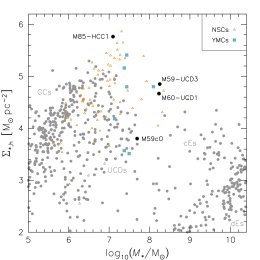Two surprisingly small heavy-weights have been discovered around galaxies in the nearby Virgo cluster by a team led by undergrads Michael Sandoval and Richard Vo and their advisor Aaron Romanowsky of San Jose State University. Setting a new record, these two objects now hold the title of the densest galaxy and the densest free-floating stellar system ever observed.
Classification Difficulties
What is the difference between large star clusters and small galaxies? Once thought to be distinct categories, the decade-old discovery of a new class of object, ultracompact dwarfs (UCDs), blurred the line between them somewhat: UCDs sit awkwardly between the two categories in size, mass and luminosity. So what are UCDs? It’s hard to say — in part because their full range of possible parameters has yet to be carefully explored.
Sandoval and his team set out to address this problem by combing through archival data from the Sloan Digital Sky Survey, searching for objects that display properties between those of star clusters and galaxies. Their search yielded two especially interesting objects: one around the galaxy M59, and the other around M85 (see figure 2). Follow-up observations with Subaru Telescope and the Southern Astrophysical Research telescope provided additional imaging and spectroscopic information.

Plot of stellar surface mass density vs. mass of known stellar systems. The data include the two new objects (M85-HCC1 and M59-UCD3) as well as globular clusters, UCDs, and compact elliptical galaxies. Credit: Sandoval et al. 2015
Record-Breakers
What makes these two discoveries so unusual? Both are remarkably dense compared to similar objects! The first, M59-UCD3, was categorized as an ultracompact dwarf galaxy — but it’s significantly more dense than any other galaxy discovered. The night sky in M59-UCD3 would appear to contain roughly a million stars, compared to the few thousand we see overhead here in the Solar neighborhood.
M85-HCC1 is another ten times denser than even that! It’s such an unusual stellar system that it defies classification in the usual categories, which is why Sandoval and collaborators created a new name for this type of object: hypercompact cluster.
In spite of the differences between these two stellar systems, the team argues that there is evidence that they were formed the same way. They believe that both objects are galactic centers that have been tidally stripped of all of the outlying stars and gas, leaving only the dense cores behind. They argue that this could be caused by mergers of M59 and M85 with intermediate mass galaxies. If true, searching for more of these unique objects could provide us with clues to how galaxies were assembled.
Citation:
Michael Sandoval et al. 2015 ApJ 808 L32 doi:10.1088/2041-8205/808/1/L32
Bonus:
Check out this cool visualization from the authors of how tidal stripping of a small galaxy might happen. This is one theory of how UCDs are formed.

